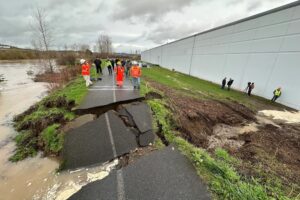SACRAMENTO, Calif. — The California Air Resources Board (CARB) has approved the final proposed 2022 Scoping Plan — a roadmap to address climate change that attempts to cut greenhouse gas emissions by 85% and achieve carbon neutrality in 2045.
The 2022 Scoping Plan provides a detailed sector-by-sector roadmap to guide the world’s fourth-largest economy away from its current dependence on petroleum and fossil gas to clean and renewable energy resources and zero-emission vehicles, according to a news release.
“The action by CARB finalizes a process to develop the final plan that has been in development for two years,” the news release stated. “The plan draws on and continues several climate programs currently in effect but also says that there’s a need to radically accelerate and increase the pace and scale. This includes an accelerated target of a 48% reduction of greenhouse gas emissions below 1990 levels by the end of the 2020s and an economy-wide shift away from fossil fuels in 2045.”
The plan aims to:
- Reduce fossil fuel consumption (liquid petroleum) to less than one-tenth of what we use today — a 94% reduction in demand.
- Cut greenhouse gas emissions by 85% below 1990 levels.
- Reduce smog-forming air pollution by 71%.
- Create 4 million new jobs.
- Save Californians $200 billion in health costs due to pollution in 2045.
The 2022 Scoping Plan includes a commitment to build no new fossil gas-fired power plants and increases support for mass transit. It also calls for a multi-agency process to ensure that the transition away from oil extraction and refining is equitable.
“Implementing this plan will achieve deep decarbonization of our entire economy, protect public health, provide a solid foundation for continued economic growth and drastically reduce the state’s dependence on fossil fuel combustion. It will clear the air in our hardest hit communities,” CARB Chair Liane Randolph said.
The plan also includes actions to capture and store carbon through the state’s natural and working lands (including its forests), and calls upon a variety of mechanical approaches to remove and safely store carbon dioxide to address the remaining 15% of greenhouse gas emissions that will remain in 2045 after the stringent direct reductions from every regulated source.
“The plan aims to keep California’s economy on track for continued growth of the economy and jobs,” according to the news release. “This includes high-road jobs tied to industries such as zero-emission car and truck manufacturing that position California as a major competitor in the global clean-energy marketplace. Economic modeling indicates that, under the plan, California’s economy will reach $5.1 trillion by 2045 (from $3.2 trillion today), with a related increase of at least 4 million new jobs.”
The initial draft of the 2022 Scoping Plan was considered by the Board in June 2022 and discussed with the EJAC in September. The final plan includes changes requested by the Board and Gov. Gavin Newsom, public comments and recommendations from the EJ Advisory Committee. It also reflects direction from new state laws passed by the Legislature this year.
As a result, the final modeling for the Scoping Plan projects a 48% reduction of greenhouse gases below 1990 levels in 2030, surpassing the minimum statutory emissions reduction goal of 40% below 1990 levels in 2030.
The updated modeling also includes 3 million climate-friendly homes by 2030 (and 7 million by 2035), 6 million heat pumps deployed by 2030, no new fossil gas capacity in the electricity sector, and 20 gigawatts of offshore wind capacity by 2045.
Additionally, the plan provides the Climate Vulnerability Metric, a new tool to identify communities especially vulnerable to harm from a changing climate and worsening air quality.
The Trucker News Staff produces engaging content for not only TheTrucker.com, but also The Trucker Newspaper, which has been serving the trucking industry for more than 30 years. With a focus on drivers, the Trucker News Staff aims to provide relevant, objective content pertaining to the trucking segment of the transportation industry. The Trucker News Staff is based in Little Rock, Arkansas.
















The EPA has also created tighter emission standards effective in 2027 for all diesel trucks. Again, this will only hurt the industry as these standards will only raise prices of trucks and their future maintenance costs. Just take a look around, many independents are hanging on to their older trucks longer because they see no upside to newer equipment. EPS has done the same to automobiles which only caused the average age of vehicle to increase. It is just another way to incentivize buying EV trucks which for most isn’t even a feasible option. The insanity of it all, is that this is like spitting on a forest fire in terms of carbon emissions.